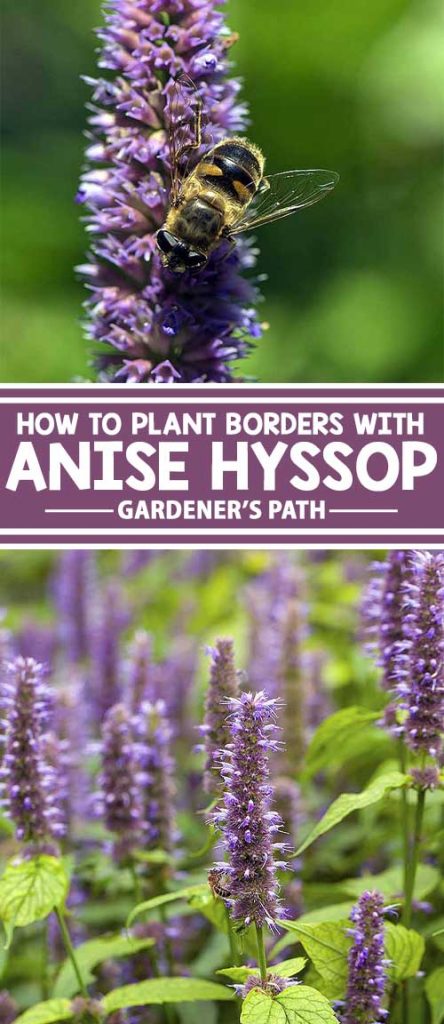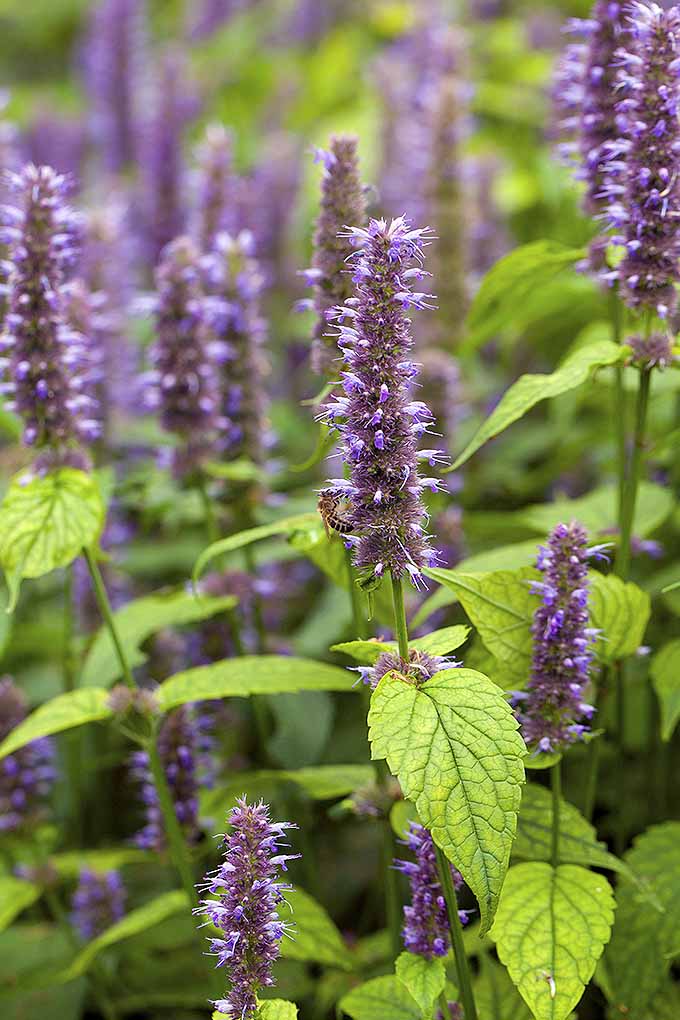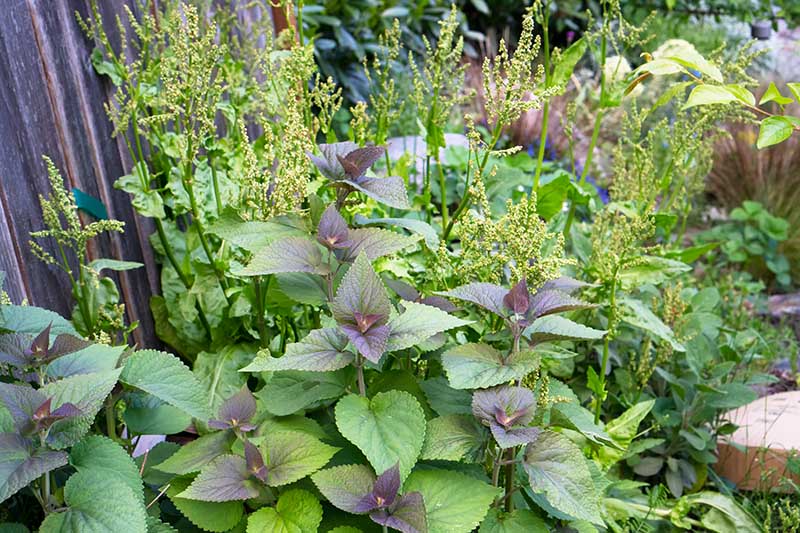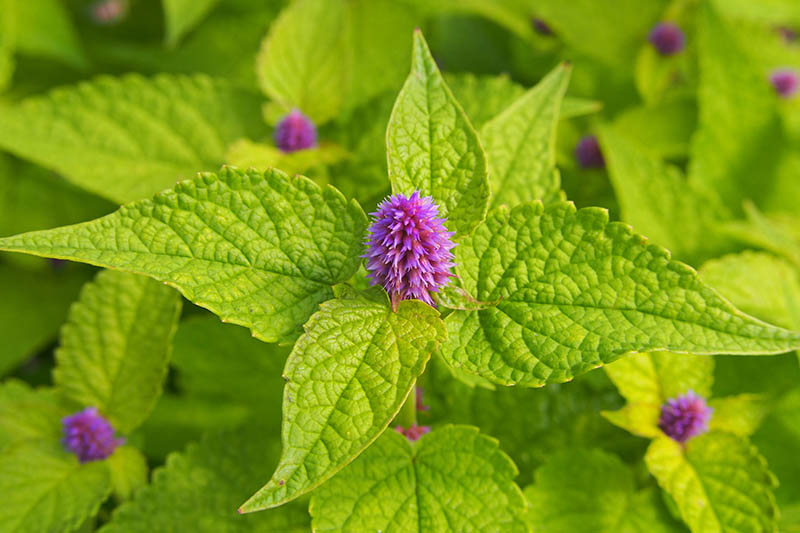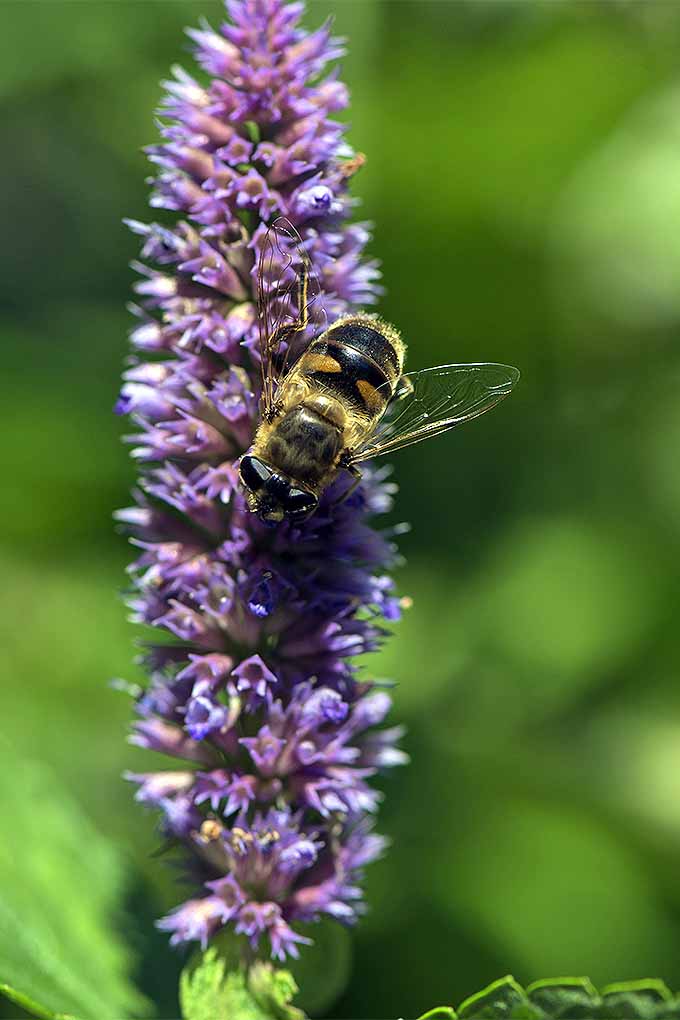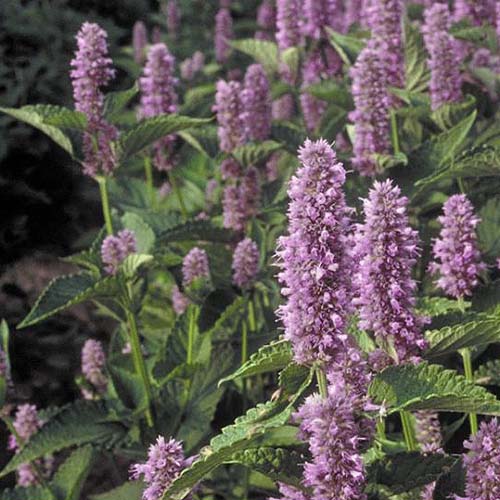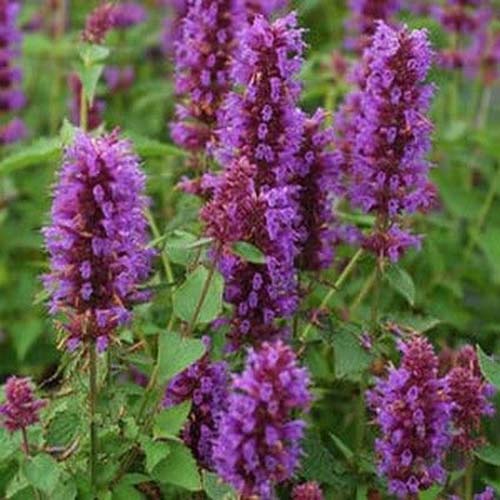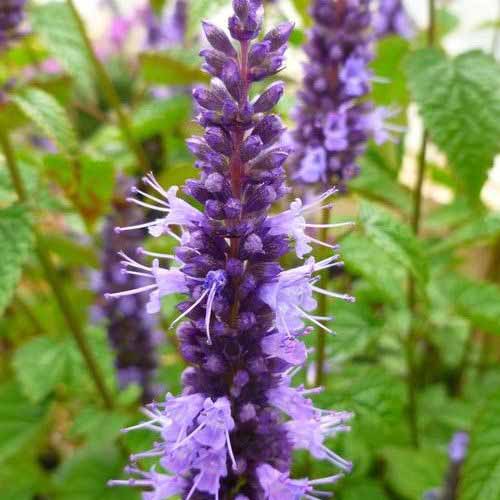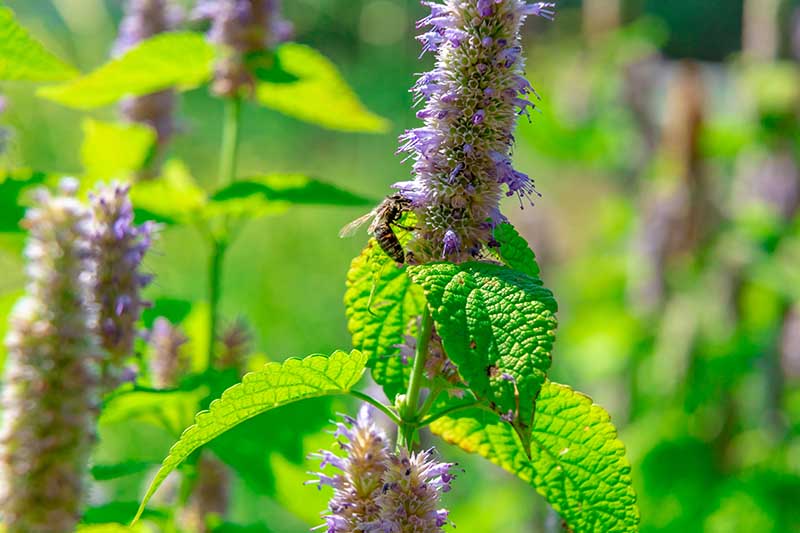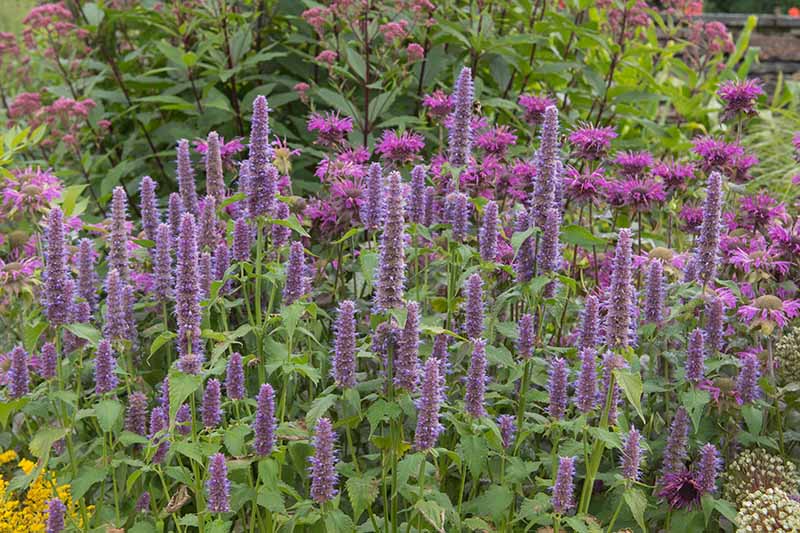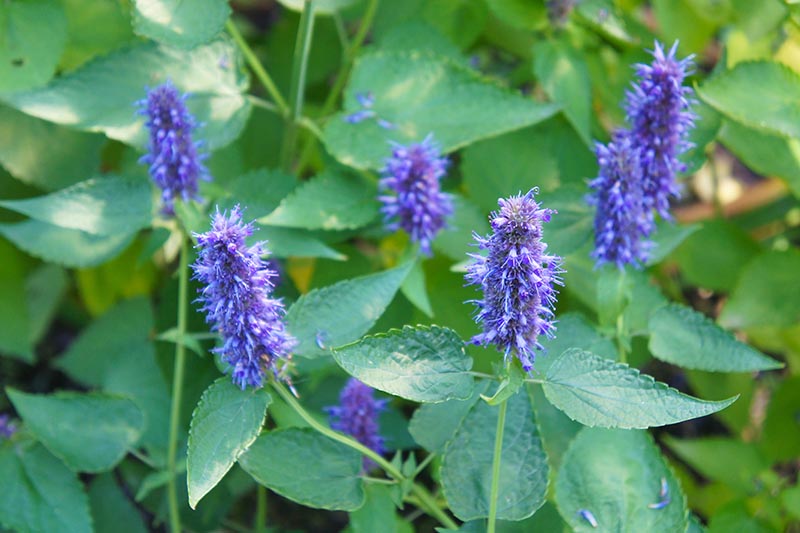It’s a native plant suited to gardens in USDA Hardiness Zones 4 to 9. Long used in culinary and medicinal applications, its erect stature and spikes of lavender blossoms make a striking statement in the garden. We link to vendors to help you find relevant products. If you buy from one of our links, we may earn a commission. Here’s what’s in store: Don’t be deterred by the “short-lived” description. Although A. foeniculum has a lifespan of about three years, it self-sows readily and has a vigorous root system, enabling it to naturalize in open spaces. Whether you plan to enjoy it as an ornamental, or harvest the leaves and flowers for their flavor and restorative properties, this deer- and rabbit-resistant herb brings much to the home garden. Let’s learn all about it!
Cultivation and History
The name “anise hyssop” is somewhat confusing, as it is neither anise seed (Pimpinella anisum) or star anise (Illicium verum), nor hyssop (Hyssopus officinalis). It grows wild in northern regions of North America, sprawling across open prairie land and creating vast stretches of lavender blossoms from June to September.
Erect, square stems rise from thick rhizomes, and plants have a bushy, clumping growth habit. Mature heights are between two and four feet, with a spread of one and a half to three feet. Also called fragrant, lavender, or blue giant hyssop, this is an aromatic herb. The leaves have a refreshingly sweet smell and taste, like a combination of anise, licorice, and mint. Arranged in opposing fashion, the leaves are medium green, and shaped like spears with scalloped edges. In the spring, the foliage may be tinged with purple. Rising above the paired leaves are spikes of light blue, lavender, or purple unscented blossoms. They are tiny, lipped, and tubular. Each is filled with rich nectar, and is the perfect length for insects with a long proboscis, such as mining bees, to take a sip. Hummingbirds love to visit these flowers as well, and the plants are sometimes also referred to as hummingbird mint. Herbalists, including Native Americans, have used the edible flowers, leaves, and stems of A. foeniculum for centuries in preparations believed to have an array of beneficial properties. The blossoms are often eaten as a salad garnish, and fresh or dried leaves may be brewed into a soothing tea.
Propagation
There are three ways to propagate anise hyssop. Let’s look at each method:
From Seed
A. foeniculum seeds germinate well after exposure to cold and moist conditions. This process is called cold stratification. The best way to start seeds is to sow them directly into the garden in early fall, so they can experience natural cold stratification during the winter months. Unlike many seeds, those of A. foeniculum need light to germinate. Moisten the soil and sprinkle on them on top about three inches apart, then gently press them down. Keep the soil moist over the winter months, watering just before it completely dries out. In the spring, the seeds will sprout. When the seedlings have at least two sets of true leaves and are fairly sturdy, thin them to a distance of one and a half to three feet apart, depending upon the mature width of the variety you have sown. You can check your seed packet to determine the mature dimensions. Expect blooms in the first year after sowing. Alternatively, you can manually replicate the cold stratification process. To do this, store seeds on top of a layer of moist potting medium or sand, and place in the fridge for about a month before sowing. To get a jump-start on the growing season, start seeds indoors six to eight weeks before the last average frost date in your area. Transplant seedlings to the garden when they have at least two sets of true leaves and all danger of frost has passed. Or, direct sow cold-stratified seeds outdoors after the last average frost date has passed, for flowers in the second year.
By Division
In early spring when the first signs of new growth appear, or in late fall as winter dormancy begins, you can divide existing clumps to make new ones. This is an excellent way to replicate hybrid varieties, as the seeds from hybrids do not produce the exact traits of the parent plants. In addition, some are infertile and produce no seeds at all. You’ll need a clean, sharp shovel and some elbow grease. Please see our guide to dividing perennials for full instructions.
Stem Cuttings
Another way to begin is with semi-soft stem cuttings. This method is also a good way to clone hybrids. In early summer, after the new, soft growth of spring has begun to firm up and before budding, use clean, sharp pruning shears to cut the tip of a growing stem to a length of about six inches. Strip the bottom leaves to reveal a bare stem that is two to three inches long. Dip the stem into powdered rooting hormone and place it in a container filled with your choice of potting medium to a depth of at least two inches. Place the stem cutting in a bright location, out of direct sunlight. Water before the potting medium completely dries out to maintain even moisture, but never allow it to become soggy. At first the stem will wilt, but it will soon perk up. When new growth is evident, you’ll know it has grown roots. Transplant the rooted cutting to the garden. It will wilt again, at first, but will rebound in time. Maintain even moisture while the young plant becomes established.
How to Grow
With seeds, divisions, or stem cuttings, you are ready to introduce A. foeniculum to the garden.
Here’s how: Choose a full sun location in your garden. Part shade is acceptable, particularly in warmer climates. Do not cultivate near black walnut trees, as A. foeniculum does not tolerate juglone toxicity. The soil should have a slightly acidic to neutral pH of 6.0 to 7.0. It can range from organically rich to poor, provided it is well draining. If you are not sure of your soil’s pH, you can conduct a soil test through your local agricultural extension. Before planting, work the soil to a crumbly consistency. If you are working with dense or clay soil, loosen it by working in a layer of builder’s sand. If you need to increase acidity, you can add leaf mulch or compost. These soil amendments will also help to improve drainage.
If you direct-sow seeds, moisten the soil and press them gently into the top of the soil, but do not cover them. Keep the soil evenly moist during germination. To transplant seedlings, wait until they have two sets of true leaves and all danger of frost has passed, and then harden them off. To do this, set them outside in a sheltered spot for a few hours each day, increasing the time spent outdoor gradually over the course of a week. After hardening off, transplant seedlings to the garden and keep them evenly moist while they become established. Transplant stem cuttings when they show signs of new growth. Keep them evenly moist while they make the transition and begin to settle in. Remember that wilting during periods of transition is to be expected, and this is usually brief. Once established, water as needed to keep the soil from completely drying out, but not so often as to oversaturate it.
Growing Tips
Use cold, moist stratification and start seeds indoors in the spring, or sow outdoors in the fall, for flowers in the first season.
Provide excellent drainage to prevent oversaturation.
A. foeniculum doesn’t like wet feet, so water when there’s still a hint of moisture in the soil, but before the ground dries out completely.
Expect wilting during periods of transition, but know that plants will soon rebound.
Maintenance
Once established, most native species require little supplemental water and care. However, there are some things you can do to keep your plants healthy and happy.
Keep the planting area clear of weeds to reduce competition for water and nutrients, maintain good airflow, discourage pests, and inhibit disease. Fertilize with an all-purpose, well-balanced product, such as 10-10-10 (NPK), in the spring. Deadhead spent blossoms by cutting them off at their points of origin, to encourage more blooming at intermittent intervals. You can also prune deeply after the first flush of blooms, to a maximum of one-third the size of the clump, to promote a second flush. Prune lightly just above a leaf node for more bushy growth, and remove damaged stems as needed. Check plants regularly for signs of disease. Act promptly to remove and dispose of affected material, or treat as needed. We’ll discuss possible issues shortly.
Cultivars to Select
In addition to the true species as found in nature, there are cultivated varieties of A. foeniculum. Some are hybrids of A. foeniculum and Korean mint, A. rugosa. Here are a few of my favorites:
Botanical Species A. foeniculum
The species as found in nature has pale lavender flower spikes and medium-green foliage.
Botanical Species A. foeniculum Stems reach mature heights of three to four feet, in two- to three-foot-wide clumps. Find plants in 3-inch containers available from Nature Hills Nursery.
Blue Boa
This cultivar has impressive spikes of deep blue-violet blossoms and gray-green foliage.
‘Blue Boa’ Mature plants reach between two and three feet tall, with a spread of 14 to 18 inches. Find ‘Blue Boa’ now from Nature Hills Nursery.
Little Adder
This variety has spikes of violet-blue flowers and medium-green foliage.
‘Little Adder’ It has a smaller stature than some of the others, topping out at 15 to 18 inches tall, and 18 to 22 inches wide. Find A. rugosa ‘Little Adder’ now from Nature Hills Nursery.
Managing Pests and Disease
As a native plant, anise hyssop is not prone to trouble from pests. However, it may become vulnerable to fungal disease in the presence of excess moisture, due to:
Inadequate air space between plants Overwatering Poor drainage
High relative humidity between plants that prevents moisture from evaporating, and pooled water on foliage and in the soil, can create an environment conducive to fungal growth. This can lead to the onset of various fungal diseases. The main ones to be aware of are:
Crown rot Leaf spot Powdery mildew Rust
In the event of a fungal infection, remove and dispose of affected foliage, and treat with a fungicide as per package instructions.
Best Garden Uses
I have always enjoyed growing anise hyssop. It is a favorite of pollinators like the bees, butterflies, and hummingbirds that feed on its nectar, and the birds, such as goldfinches, that adore the seeds.
And, as a native species that requires little maintenance and water once established, it’s suitable for xeriscaping. Whether you’re looking for an exciting, flavorful addition to the herb garden, or an ornamental that doesn’t appeal to deer or rabbits, it is well worth your consideration. Here are some ideas for introducing A. foeniculum to your outdoor living space: Plant it in butterfly and wildflower gardens where pollinators feed. Give it a drift of its own where it can spread unchecked, as it does in the wild. If you can only spare it a few pots on the patio, so be it. Choose large containers with 18- to 20-inch rims and a depth of at least 12 inches for ample root space. Add it to the cutting garden for a ready supply of stems for fresh or dry vase arrangements. A. foeniculum pairs well with a host of perennials that also appreciate room to roam, perhaps through a meadow or sprawling border, including:
Bee balm Brown-eyed Susan Coneflower Globe thistle Joe-pye weed Ornamental grasses Russian sage Yarrow
And finally, it’s a winner in foundation beds. Choose a mid-height variety for a center placement, or a taller one for a rear position, to create a spiky blue, lavender, or purple backdrop for lower-profile front-of-bed specimens.
Harvesting and Preserving
Anise hyssop leaves can be used in cooking as a substitute for mint. They make a refreshing addition to fresh fruit cups and summer salads.
To harvest fresh leaves, pinch them off as needed, or store them in a zippered plastic bag in the fridge for about one week. You may also snip off flowers or entire flower heads just before they are fully open, to use as garnishes on special desserts. And, if you like to arrange flowers and foliage, you can cut entire stems just as the flowers are beginning to open, to display in vase arrangements. You may also enjoy dried anise hyssop. To dry leaves, flowers, and stems for culinary purposes, as well as floral arranging, harvest stems when most of the flowers have opened, but before they are full-blown and ready to drop. The best time to cut them is after the morning dew evaporates, and before the day gets hot. Cut the stems as long as you like. Bunch them with twine and hang them upside down in a location that is airy, warm, and dry. Darkness may help preserve their color. Allow about two to three weeks for the stems to fully dry. To store, use airtight jars to hold crumbled leaves, flowers, and stem portions. They should retain their best flavor for about one year. We have more tips on drying and storing herbs here. To harvest seeds for sowing in the garden or sharing with friends, wait until the flowers drop and the seed pods form.
Gather the stems, and bunch and hang them as described above, but with a clean cloth or paper bag placed underneath to catch seeds that fall as they dry. Another method of seed collection is to tie paper bags around the flower spikes after they finish blooming, to catch the seeds before they fall to the ground. This can be tricky, though, since they grow upwards! Sow saved seeds immediately or store in a labeled envelope for sowing as needed. As a native species, it’s a practical choice that’s both low-maintenance and water-wise, spreading via rhizomes and self-sowing in ideal growing conditions. In addition, it is an excellent food source for local pollinators.
If you like this plant, another lavender-hued herb you may enjoy cultivating is lavender itself, also known as Lavandula. You can check out our growing guide to learn more. Does anise hyssop grow in your garden, and do the deer leave it alone? Let us know in the comments below, and feel free to share a picture! And for more information about growing flowers in your garden, try these guides next:
How to Grow Black-Eyed Susans, a Garden Favorite How to Grow Sunflowers, a Beautiful and Tasty Addition to Your Landscape Growing Heliotropes: Fragrant Vintage Charmers
© Ask the Experts, LLC. ALL RIGHTS RESERVED. See our TOS for more details. Originally published February 20, 2019. Last updated: June 4, 2020. Product photos via Nature Hills Nursery. Uncredited photos: Shutterstock.
